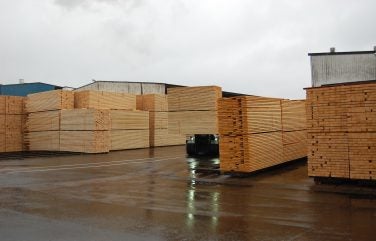
When it comes to trading, this year’s UK softwood market fell far short of most importers and merchants’ expectations. With the year-end in sight, the current mood among UK distributors is one of resignation that an upturn is unlikely to materialise before the New Year.
Taking all softwood product groups into consideration, demand for construction grades in particular fell away, steeply declining since July. C24 specifications have been the most affected, engendering fierce competition between wholesalers that forced prices down on virtually a monthly basis.
For those sellers driven by volume targets and operating from quayside facilities, weak demand created lower stock-turn rates, and at inventory-linked ports, quay rental charges threatened to add to costs creating additional pressure on sellers to slash prices and force stock into the market.
As the UK developed into a cut-throat market, some Baltic mills gave up on carcassing specifications focusing instead on alternative products. By employing a greater emphasis on fuelwood, fencing, packing and pallet specifications, they managed to achieve more realistic financial returns.
This switch away from building grades has proved to be a relative success, as Latvia’s share of the UK import volume has actually grown on a percentage basis although exports of building timber have reduced. The switch can be physically seen at several UK ports, where higher volumes of treated and rounded posts for agricultural fencing have replaced areas of cargo space previously reserved for KD carcassing.
Turning to the quality grades, so far this year the market for unsorted, fifths and sixths has remained consistent, and overall prices have held firm. While the MENA markets have been fairly active for the Nordic mills, Japanese buyers have recently been reducing purchases due to stock levels with the result some shippers speak of a surfeit of 4.8m lengths in redwood. It is possible that these may be processed into strength-graded carcassing sizes. The availability of wider sideboards (200/225mm) in unsorted and fifth redwood has been quite scarce which may be attributed to the earlier harvesting of logs leading to smaller diameters.
Demand for packaging and pallet dimensions has continued at a steady pace through the year with prices holding their ground, and late shipments creating shortages in 16mm sixth-grade boards. Looking forward, demand in mainland Europe for packing grades (emballage) could be affected by a growing weakness in German industrial production and exports, these have recently been underlined by Volkswagen’s announcement over factory closure plans. In the year to the end of September, German industrial output fell by around 4.5%, and in September alone, output dropped by 2.7% with exports falling by 1.7%.
In the UK, the weak demand for structural wood has been masking the fact that there are shortages in the supply chain, and whitewood logs across southern Sweden are difficult to acquire in suitable volumes. In the current market, several mills are substituting redwood on their production lines to compensate. While in Latvia, whitewood specifications have also been in short supply following an ongoing state forestry plant health ban on cutting spruce. This has reduced overall availability, with mostly private forest owners left to supply the market.
In northern Europe, shippers have recently received increasing interest from the US, and some Scandinavian mills have been closing contracts for substantial volumes. There is also evidence that shortages in sawlogs are biting as specifications are becoming harder to fulfil due to shortages of certain lengths. At present 3.0m are in short supply, and mill production is falling behind.
Without taking the influence of demand into account, shortages in supply may well become the driver to reverse the market decline and push prices upwards direction. Once again, the trade may witness another round in the perpetual trend of feast or famine.
The UK softwood trade’s performance has been related to a downturn in construction activity, housebuilding and ultimately expenditure in the general economy. Timber and builder’s merchants have witnessed growing delays in getting paid by contractors, while the importers’ credit insurers have been reducing credit limits or even withdrawing cover completely on some of their merchant customers.
As the UK digests the impact of the new Labour government’s budget delivered on 30th October, reactions from the building and construction sector have welcomed the pledges made to fund new housing. The timber industry would like to have seen a greater emphasis on low carbon construction, which would favour an increase in wood-based design. For speed and efficiency in the new housing market, it is more than likely that timber frame off-site construction will expand through 2025, delivering more eco-efficient units.
In the British forestry sector, there was a sigh of relief among growers after they escaped the budget relatively intact when compared to the livestock and arable farmers, where future generations are now facing punitive inheritance taxes that may cause closures. Recent threats by farmers to block ports could if implemented, cause serious delays to timber logistics with associated costs.
In the softwood industry, traders still see tough times ahead. Everyone is hoping that increased expenditure in new UK housing, infrastructure and construction will provide a stimulus to kickstart demand. Only time will tell if that aim materialises.






